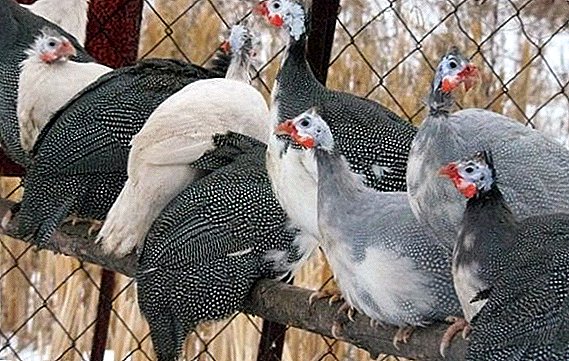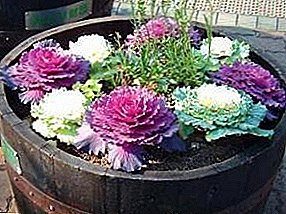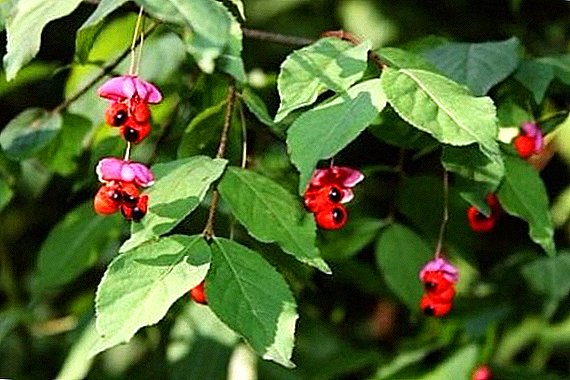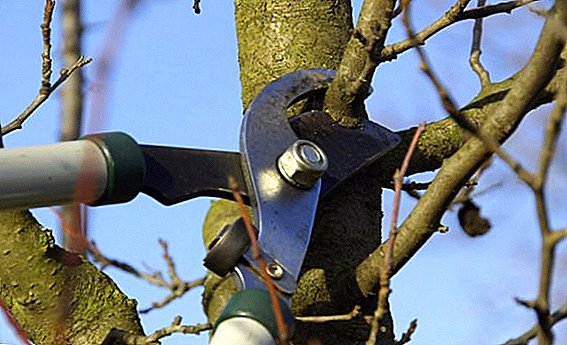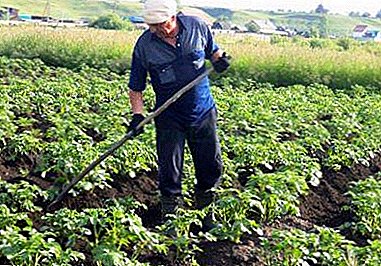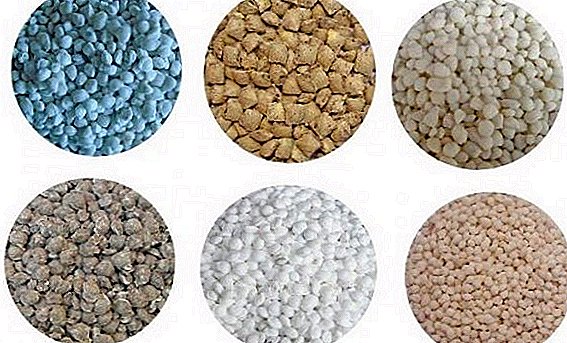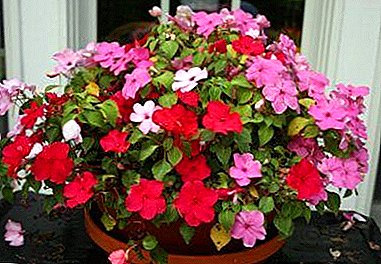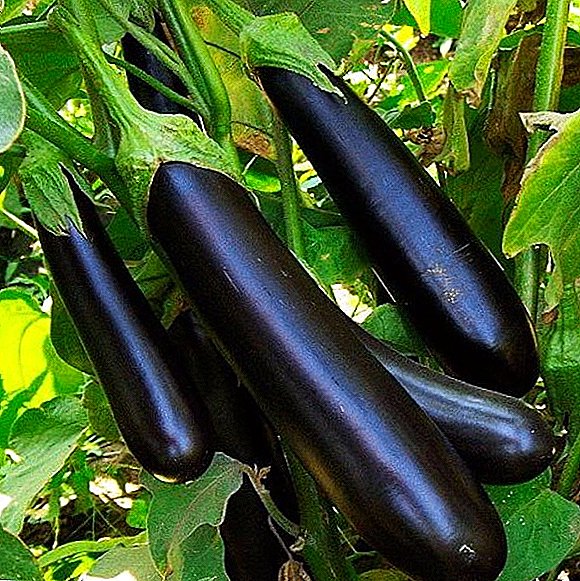 Growing eggplant is not an easy process. After all, this vegetable is thermophilic, does not tolerate sudden changes in temperature and requires constant attention and regular care arrangements.
Growing eggplant is not an easy process. After all, this vegetable is thermophilic, does not tolerate sudden changes in temperature and requires constant attention and regular care arrangements.
However, to simplify the task and achieve a good harvest can be subject to the proper selection of varieties to the surrounding climate and the observance of the rules for growing blue ones. In the article we picked up important recommendations on how to grow eggplant "Clorinda F1".
Grade Eggplant "Clorinda F1"
To begin with, we offer a small acquaintance with the variety of eggplant "Clorinda F1" and its description.
This variety refers to the medium. Its growing season is 66-68 days. Bred it in Holland. The stems of the plant grow to a length of 80-100 cm.
It is characterized by a high set of fruits and a long phase of fruiting. The average yield - 5.8 kg / 1 square. m 
Did you know? Marking "F1" in the title indicates that this variety is a hybrid and the work of breeders to cross several varieties. The number "1" denotes the generation number. As a rule, the seeds of hybrids are much more expensive than ordinary varieties, because the hybrid forms give them in small quantities or do not give at all. In addition, these varieties are resistant to disease, cold and other stresses. But to multiply the hybrid at home is impossible.
Gives fruit oval pear-shaped. On average, they grow to sizes 12 x 25 cm. In diameter reach 10 cm. They have a mass of 1.5 kg.
The color of eggplant peel is dark purple, glossy. The flesh of the fruit is white, it does not darken when cut.
Clorinda F1 has good resistance to cold, stress, tobacco mosaic..
The variety is suitable for planting in the garden, in greenhouses and greenhouses. In closed conditions, it is preferable to grow it on vertical supports: stakes, trellis. So you can achieve the greatest yield.
In the garden plot for growing eggplants it is also advisable to build supports. Before planting blue ones in open or in closed ground, it is better to grow seedlings.
Did you know? In the greenhouse "Clorinda F1" usually gives 320 kg per one hundred square meters, in the garden - 220 kg.Like any eggplant variety, Clorinda F1 prefers:
- air temperature +25 degrees and above;
- no temperature drops;
- well-moistened soil in the fruit setting phase.
Together with eggplant you can plant vegetables such as peas, peppers, potatoes, tomatoes, thyme, cucumbers, spinach, basil.
As you can see from the description of the manufacturer, the variety Eggplant "Clorinda F1" has excellent characteristics. But whether this is in fact, we learn from the impressions of gardeners who have already dealt with growing this hybrid in practice. Here are a few reviews:
Hope: "These hybrids grew in my beauty of extraordinary. Very large and beautiful fruits (a little less than 700 g). I grew it in a greenhouse. The shrubs grew about 70 cm in height. I am very pleased.
Marina: “A beautiful plant, powerful and prolific. It grew these eggplants in a film greenhouse in the Moscow region. I grew large fruits. Their peels were thin and there were almost no seeds. The taste was very sweet.”
Where better to grow
As we have already noted, the variety is suitable for cultivation in open and closed ground. Since the first method is more problematic, let us tell about it. If you plan to plant in the greenhouse, the seeds are recommended to sow no later than mid-March. The seedling is planted from May 25 to June 10.
Lighting
Well-lit areas are great for eggplants, such as where sunlight does not last longer than 12 hours a day. The place must be protected from drafts.
Soil requirements
The best predecessors for blue ones will be cucumbers, carrots, cabbage, onions, melons, watermelons. It is undesirable to plant them after tomatoes and peppers.
To achieve the greatest yields, vegetables should be grown on light fertile soil. Therefore, if your garden can not boast of such, the beds will need to be prepared in advance. For example, in a soil rich in peat, mix soddy earth; the land consisting mainly of sand is diluted with a mixture of clay soil with peat. Clay soil should be fertilized with peat and river sand. Peat to the loam.
Important! In order for the soil to become light, sawdust and chopped straw are added to its composition. Feed the humus or compost - they make the fall and spring under the digging.In the spring, you can also fertilize the ground with wood ash (300-500 g / 1 sq. M) or superphosphate (50-150 g / 1 sq. M).

How to plant
To seed germination was as close as possible to one hundred percent, before sowing it is necessary to make a number of manipulations with the seeds.
Seed preparation time
Typically, the hybrid "Klorinda" has a high degree of germination. Nevertheless, the seeds still need to be processed before sowing. First, they will require disinfection for 30 minutes in a strong solution of potassium permanganate, and then soaking in hot water for 30 minutes.
The best germination is provided by soaking for 24 hours in aloe juice or for 10 minutes in a hot (40 °) aqueous solution of hydrogen peroxide (3 ml / 100 ml of water).
Sowing scheme
For Clorind's aubergines, the following planting patterns are recommended:
- 0.7 x 0.7 m;
- two plants per 1 square. m in open ground;
- 0.7 x 0.7-0.8 m;
- 1.8-2 plants per 1 square. in chess order.

Rules for the care of seedlings and the subsequent landing in the ground
For seedlings, seeds are planted one by one in separate cups, special cassettes or plastic bottles. The soil is prepared from:
- Garden land, sand; soil store mix for seedlings (1: 1: 1); experienced gardeners are also advised to add vermiculite.
- Compost, turf land, manure (8: 2: 1).
- Peat, sawdust (3: 1), soil mixture for seedlings.
- Sod land, compost, sand (5: 3: 1).
Important! Before planting, the soil must be decontaminated by heating it in an oven or microwave.The time that is recommended to choose for sowing seeds for seedlings - the end of February - mid-March.
After sowing, the seed containers are covered with polyethylene and placed in a place where it is possible to maintain the temperature at a level of 25-28 degrees.
After the sprouts appear, the cover is removed from the tanks. In the first week they provide the plants with a temperature of 16-17 degrees. In the future - 25-27 ° C during the day and 13-14 ° C at night. Lowering below 14 degrees should not be allowed, because seedlings at lower temperatures may die.
It is recommended to periodically make seedlings on the street for hardening.
Caring for seedlings will consist in regular watering with warm settled water, loosening the soil and fertilizing fertilizers containing fluorine (for example, "Criston"). It is important that the water during watering does not fall on the leaves of sprouts, as this can provoke fungal diseases.
If the days of germination will often be overcast, the plant needs to provide additional illumination for 12-14 hours. Capacities with seedlings must be periodically rotated so that the light is accessible to each side of the shoots.
In the open ground, plants that have reached 20 cm in height and have six to eight leaves, are transplanted into pre-prepared and watered holes in the period from May 25 to June 10. Planting depth - to the first lower leaves. The soil around the planted sprouts mulch. In the first weeks of landing it would be good to cover the film.
When disembarking, it is advisable to adhere to the distance between the bushes of 30-40 cm, between the beds - 60 cm.
Features of care and cultivation
For successful fruiting, eggplant will need regular watering, loosening the soil beneath it, pinching bushes and top dressing. Also, the bushes with large fruits formed will need to be tied up.
To have a good harvest of eggplants, you need to take care of their protection from pests.
Top dressing and watering
After planting seedlings in open ground, it must be watered every two to three days. In the subsequent watering will need once a week. Water consumption - 10-12 liters per 1 square. m
Eggplant will need from three to five feedings. The first is carried out after two to three weeks after landing in the ground. As fertilizers use organic matter (mullein) and mineral additives ("Mortar"), the introduction of which alternate.
Forming a bush
One of the advantages of the Clorinda F1 is that the hybrid practically does not require the formation of a bush. When plants reach a height of 25-30 cm, they need to cut off the tops to give an incentive for the formation of lateral shoots.
When the first side shoots appear on the plant, two or three strongest ones are selected, the rest are torn off.
On the main stem all the shoots and leaves are cut off before the first fork. Above the fork get rid of those shoots where there are no ovaries. It is also necessary to remove sick, weak, yellow leaves and irregularly shaped fruits in time.
Soil care
It is important to ensure that the soil is not compacted. Loosening is carried out at least four or five times per season. He is accompanied by obligatory hilling.
Loosen the soil with caution, since the root system of the eggplant is located close to the surface.
Also, care for the soil will consist in timely disposal of weeds.
When to harvest
The first fruits of eggplants will give two months after they were planted. It is necessary to wait for the flesh of the blue ones to become elastic, and the rind to get a brilliant black glossy finish. Vegetables should not be plucked, so as not to damage the stems, and cut the shears. It is necessary to cut the fruit with a 2-3 cm stem. Harvesting is carried out every five to seven days up to six times.
As you can see, the process of growing eggplant variety Clorinda F1 is not so laborious. The main thing is to know the preferences of the plant and ensure the proper agricultural practices. Take care of the vegetable from temperature fluctuations, maintain the required soil moisture, do not forget about regular dressings, and it will generously give you a rich and tasty harvest.



